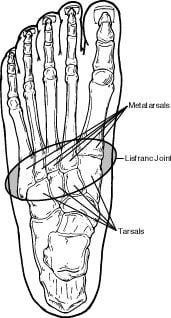Put Your Feet In Our Hands
Schedule an appointment
The Lisfranc Joint
 The Lisfranc joint is the point at which the metatarsal bones (long bones that lead up to the toes) and the tarsal bones (bones in the arch) connect. The Lisfranc ligament is a tough band of tissue that joins two of these bones. This is important for maintaining proper alignment and strength of the joint.
The Lisfranc joint is the point at which the metatarsal bones (long bones that lead up to the toes) and the tarsal bones (bones in the arch) connect. The Lisfranc ligament is a tough band of tissue that joins two of these bones. This is important for maintaining proper alignment and strength of the joint.
How Do Lisfranc Injuries Occur?
Injuries to the Lisfranc joint most commonly occur in automobile accident victims, military personnel, runners, horseback riders, football players and participants of other contact sports, or something as simple as missing a step on a staircase.
Lisfranc injuries occur as a result of direct or indirect forces to the foot. A direct force often involves something heavy falling on the foot. Indirect force commonly involves twisting the foot.
Types of Lisfranc Injuries
There are three types of Lisfranc injuries, which sometimes occur together:
- Sprains. The Lisfranc ligament and other ligaments on the bottom of the midfoot are stronger than those on the top of the midfoot. Therefore, when they are weakened through a sprain (a stretching of the ligament), patients experience instability of the joint in the middle of the foot.
- Fractures. A break in a bone in the Lisfranc joint can be either an avulsion fracture (a small piece of bone is pulled off) or a break through the bone or bones of the midfoot.
- Dislocations. The bones of the Lisfranc joint may be forced from their normal positions.
Symptoms
The symptoms of a Lisfranc injury may include:
- Swelling of the foot
- Pain throughout the midfoot when standing or when pressure is applied
- Inability to bear weight (in severe injuries)
- Bruising or blistering on the arch are important signs of a Lisfranc injury. Bruising may also occur on the top of the foot.
- Abnormal widening of the foot.
Diagnosis
Lisfranc injuries are sometimes mistaken for ankle sprains, making the diagnostic process very important. To arrive at a diagnosis, the foot and ankle surgeon will ask questions about how the injury occurred and will examine the foot to determine the severity of the injury.
X-rays and other imaging studies may be necessary to fully evaluate the extent of the injury. The surgeon may also perform an additional examination while the patient is under anesthesia to further evaluate a fracture or weakening of the joint and surrounding bones.
Non-surgical Treatment
Anyone who has symptoms of a Lisfranc injury should see a foot and ankle surgeon right away. If unable to do so immediately, it is important to stay off the injured foot, keep it elevated (at or slightly above hip level), and apply a bag of ice wrapped in a thin towel to the area every 20 minutes of each waking hour. These steps will help keep the swelling and pain under control. Treatment by the foot and ankle surgeon may include one or more of the following, depending on the type and severity of the Lisfranc injury:
- Immobilization. Sometimes the foot is placed in a cast to keep it immobile, and crutches are used to avoid putting weight on the injured foot.
- Oral medications. Nonsteroidal anti-inflammatory medications (NSAIDs), such as ibuprofen, help reduce the pain and inflammation.
- Ice and elevation. Swelling is reduced by icing the affected area and keeping the foot elevated, as described above.
- Physical therapy. After the swelling and pain have subsided, physical therapy may be prescribed.
When is Surgery Needed?
Certain types of Lisfranc injuries require surgery. The foot and ankle surgeon will determine the type of procedure that is best suited to the individual patient. Some injuries of this type may require emergency surgery.
Complications of Lisfranc Injuries
Complications can and often do arise following Lisfranc injuries. A possible early complication following the injury is compartment syndrome, in which pressure builds up within the tissues of the foot, requiring immediate surgery to prevent tissue damage. A build-up of pressure could damage the nerves, blood vessels, and muscles in the foot.
Arthritis and problems with foot alignment are very likely to develop. In most cases, arthritis develops several months or longer following a Lisfranc injury, requiring additional treatment.
Contact Us
Send Us an Email
Our Location
Find us on the map
Hours of Operation
Our Regular Schedule
Clinton Foot & Ankle Clinic, PC
Monday:
9:00 am-5:00 pm
Tuesday:
9:00 am-4:00 pm
Jonesville Location
Wednesday:
9:00 am-3:30 pm
Thursday:
Closed
Friday:
Dates May vary Depending on surgery Schedule
9:00 am-12:00 pm
Saturday:
Closed
Sunday:
Closed